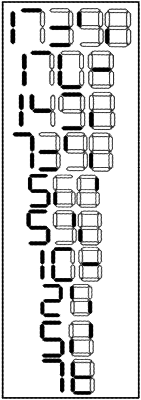| CPC A61B 5/161 (2013.01) [A61B 3/02 (2013.01)] | 6 Claims |

|
1. A method for measuring flicker fusion threshold based on digital set identification, comprising the following steps:
1) setting a measurement scheme, including setting N 8-shaped digital frames in a background light area that flickers within a set frequency, where the N takes on a value of 2 to 4, and assigning a name to each stroke of the 8-shaped digital frame, specifically in the 8-shaped digital frame:
three horizontal strokes are sequentially called a first horizontal stroke, a second horizontal stroke, and a third horizontal stroke from top to bottom; a first vertical stroke is between the first horizontal stroke and the second horizontal stroke on the left; a second vertical stroke is between the second horizontal stroke and the third horizontal stroke on the left; a third vertical stroke is between the first horizontal stroke and the second horizontal stroke on the right; and a fourth vertical stroke is between the second horizontal stroke and the third horizontal stroke;
2) setting ten groups of different frequency combinations that are applied to the N 8-shaped digital frames, respectively, wherein a frequency range of each group of the frequency combinations is from 20 to 50 Hz;
3) assigning each frequency in each group of the frequency combinations with a stroke of the 8-shaped digital frame;
4) randomly selecting, for each of the N 8-shaped digital frames, one group from the ten groups of the frequency combinations, and selecting a total of N groups, and in the N groups, a number B1 of different frequencies in the frequency group obtained by the first 8-shaped digital frame is one more than the number B of different frequencies in the frequency group obtained by the other 8-shaped digital frames;
5) determining the value of each frequency in each group of frequency combinations in the N groups of frequency combinations described in step 4), so that 0 to N random digits flickering between 0 and 9 are presented to a subject;
6) recognizing, by the subject, the flickering digits on the N 8-shaped digital frames in the background light area within a set frequency range; and
7) determining the range of the flicker fusion threshold or a final flicker fusion threshold of the subject according to the 0 to N flickering digits that can be seen by the subject.
|